
Don Burton takes his Mayfly out for a splash in Illinois. Nice polytarp sail.
Contents:
Contact info:
Jim Michalak
118 E Randall,
Lebanon, IL 62254Send $1 for info on 20 boats.
Jim Michalak's Boat Designs
118 E Randall, Lebanon, IL 62254
A page of boat designs and essays.
(15sep06) This issue will continue the panel stiffness essays. The 1 October issue will continue the topic.
THE BOOK IS OUT!
BOATBUILDING FOR BEGINNERS (AND BEYOND)
is out now, written by me and edited by Garth Battista of Breakaway Books. You might find it at your bookstore. If not check it out at the....ON LINE CATALOG OF MY PLANS...
...which can now be found at Duckworks Magazine. You order with a shopping cart set up and pay with credit cards or by Paypal. Then Duckworks sends me an email about the order and then I send the plans right from me to you.

|
Left:
Don Burton takes his Mayfly out for a splash in Illinois. Nice polytarp sail.
|
|
|
Panel Stiffness 2
TO RECAP...In the first episode we found that when we tested a bar of our structural material by pulling on it while measuring the applied load and resultant stretch, like this...
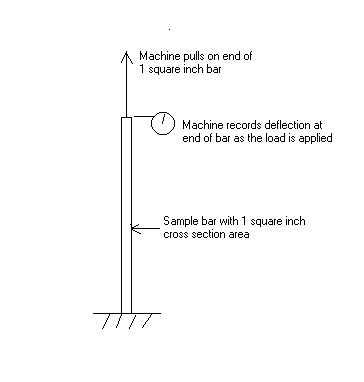
...that the amount of stretch was proportional to the applied load, that is until we exceeded the material's "yield strength". But we agreed that it wasn't wise to exceed the yield strength in any normal load since it would result in a permanent stretch or complete failure of the bar. As long as we stayed below the yield strength we could apply the load almost an infinite number of times with no detrimental affect.
Next we sat a 200 pound fellow on a board that is 8' long and 1.5" thick and 3.5" wide and it deflected a certain amount like this...

The board deflects in a curve of some sort but in order to do that the fibers on the upper side of the board must shorten and the fibers on the under side must elongate. The fibers inside the board will change length in proportion to their distance from the center or "neutral axis" of the board's cross section like this:

The amount of stretch or shortening in the fibers is called its "strain". (In this simple case the strain of the center fiber is zero.) And with the knowledge that our test element showed with this material the "stress" is directly proportional to the "strain", then we can calculate the stress in the board's fibers, like this...
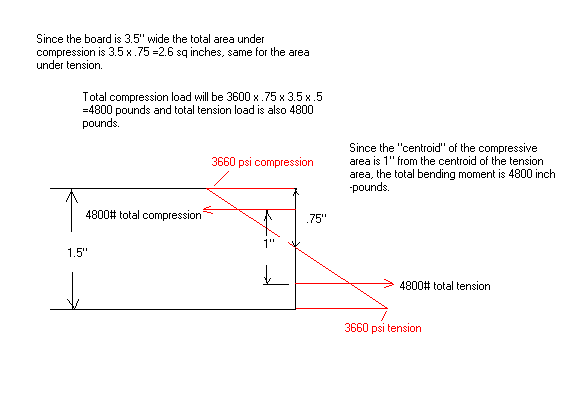
(Now, I'm going to review a bit how the calculations are done. The maximum applied bending moment is right under the man's weight and it is in numbers the 100# reaction force on the sawhorse support times the 48" distance to the center, or 4800 inch-pounds. So the forces internal to the board at that point must equal 4800 inch=pounds. OK, the top and bottom area of our strain diagram form triangles that are 3.5" wide and .75" deep (half the depth of the (2x4). Let's look at the top triangle which is in compression. The total sum of the compressive force there can be thought to act through a point .5" from the center of the board since the "average" of that triangle will act 2/3's of the way from the tip of the triangle. Same with the lower triangle which represents tension. So the two triangles can be thought to work a total of 1" apart. If so then the total load of each triangle must be 4800 pounds in order to get an internal bending reaction of 4800 inch-pounds. Now to calculate the maximum stress: Total area in compression is .75" x 3.5" or 2.625" so the average compressive stress would be 4800/2.625=1830 psi. But since the distribution is in the form of a triangle the maximum at the outer fibers will be twice that average, or 3660 psi.)
Premium wood can handle that but a cheap 2.4 may not and our man gets nervous about that and adds a second 2x4 beside the first, result in a 2x8. The stress is reduced in half since the area of the reactive triangles has been doubled in width. Since strain and deflection of the fibers is proportional to stress, then the strain here will also be half and thus the overall curvature or deflection is half.
Now the man does something interesting. Instead of laying the boards beside each other he lays one on top of the other, in effect making a 4x4 that is not joined in the middle. Now what happens? The answer is that if the two boards are free to slide over one another that the stresses are the same as for the 2x8 because the two boards are still acting independantly. In particular they are still bending to the same curve as the 2x8 and thus the same stress.
NOW, ALONG COMES THE BOLT SALESMAN...
...and he says,"bolt those two boards together, son, and watch some magic happen." He sells a lot of bolts that the man uses to secure the two boards together such that he has the equal of a true solid 4x4. The two boards can no longer slide over each other. Now when you figure the stresses in the board center you get this:

The distance between the two triangle centroids is now 2" instead of 1" as with a single 2x4. So the reactions there, keeping the applied bending at 4800 inch-pounds, will be 2400 pounds, half of the first example. Furthermore, the reactive triangles now have twice as much area, so in all the stress at the outer fibers is going to be one fourth of the first example, or 915 psi. Another way to look at it is that if you make the board twice as deep (as opposed to twice as wide) you will make it four times as strong,
NOW MORE MAGIC HAPPENS...
Since the outer fibers of the 4x4 are twice as far from the neutral axis as compared to the 2x4, they will strain twice as much for a given curvature (deflection) of the beam. Like this:

But we also know now that here the 4x4 outer fiber strains are actually one fourth those of the 2x4 strains. So the only way that will work is if the curvature of the 4x4 is one eighth the curvature of the 2x4 with the same loading situation. So the 4x4 deflects one eighth as much under the man's weight as the 2x4.
IN A GENERAL WAY...
... if you make a bending element deeper by a factor of X, then the strength will increase by X squared and the stiffness in bending in increase by X cubed.
POP QUIZ!!!
...A fellow is sailing his dinghy in rough water as is getting nervous watching the 1/4" bottom flex a half inch with each wave. He goes home and epoxies a layer of 1/8" ply to the bottom to bring it to 3/8" total. Now how much does the bottom flex? Answer, he has increased the thickness by a factor of 1.5, so the bottom is now stiffer by a factor of 1.5 times 1.5 times 1.5 which is 3.375 and now his bottom is flexing about 1/8" with each wave and he feels better about that. When you make a panel thicker you gain thickness and strength very quickly. On the other hand if you make a panel thinner you lose strength and stiffness very quickly.
NEXT TIME...we pick this topic up again to look at ways of stiffening panels.
Mayfly14

MAYFLY14, ROW/SAIL SKIFF, 14' X 4', 150 POUNDS EMPTY
Mayfly14 is a straight forward flat bottomed plywood skiff for sailing and rowing. She's easy to build because her planks have no twists. That means that the chine log and wale bevels are constant for all practical purposes and can be presawn before assembly. The construction is of the simplest nail and glue variety with no building jigs or lofting required - an "instant" boat. The prototype was built by Garth Battista and kids in Halcottsville, NY.

I think this boat is about the right size for a lot of folks, although I might argue that it is too heavy to cartop with comfort and once you decide to trailer a boat you might as well go to a sixteen footer. Mayfly14 will take two adults easily and yet still be a wonderful solo boat.

The sail rig is a balanced lug which is easy to build and stow. I recommend that my customers sew their own sails either from common polytarp (as Garth did in the boat shown above) or real Dacron sailcloth. The plans show instructions for sewing in real sailcloth. You need a sewing machine that sews zigzag stitches and cheap home machines are usually good at that. I don't claim to be the world's best sailmaker but it is not majic. I can do it and so can you. The clothes you are wearing are ten times more complex than a small sail. There are a few rules to follow and I give an essay on that with each set of sailboat plans. In fact I suggest you sew your sails before you build your hull. Both sail and hull require about the same work space. Sew the sail first, roll it up, stuff it in a closet, and now your workspace is ready for your hull. Getting the sail done can get you over a big mental hurdle.

Garth's friend Ari made this Mayfly14 shown in shallow water at Long Island Sound:
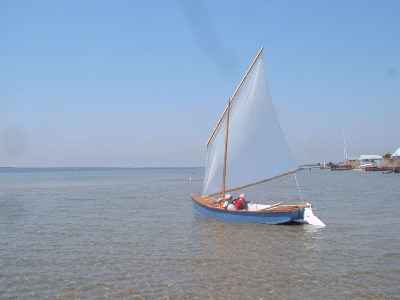
Here is another by Don Burton in Illinois:

I think there are more but I lost the photos in a hard drive crash last winter.
Mayfly14 needs three sheets of 1/4" plywood and two sheets of 1/2" plywood.
Mayfly14 plans are $30. But, the Mayfly14 plans are shown complete in reduced size in my book available from Duckworksmagazine.com along with Garth's blow-by-blow assembly photos plus a huge amount of other stuff.
Prototype News
Some of you may know that in addition to the one buck catalog which now contains 20 "done" boats, I offer another catalog of 20 unbuilt prototypes. The buck catalog has on its last page a list and brief description of the boats currently in the Catalog of Prototypes. That catalog also contains some articles that I wrote for Messing About In Boats and Boatbuilder magazines. The Catalog of Prototypes costs $3. The both together amount to 50 pages for $4, an offer you may have seen in Woodenboat ads. Payment must be in US funds. The banks here won't accept anything else. (I've got a little stash of foreign currency that I can admire but not spend.) I'm way too small for credit cards.
The out West Picara is I am told done to the point of using it as a powerboat:
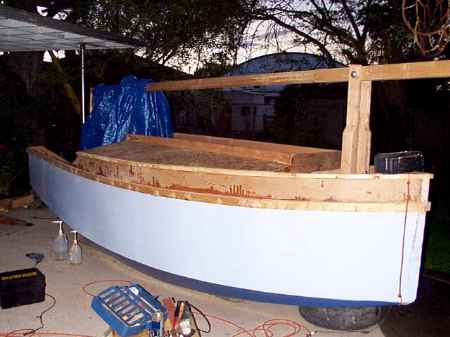
The down South Picara is more or less complete now. Lots of slick detail as you see.
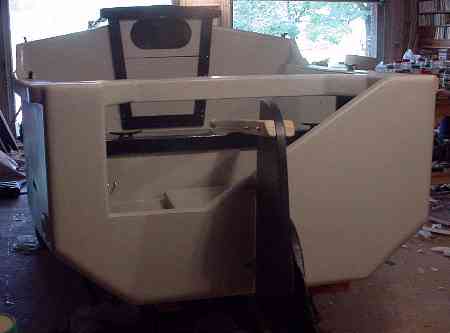
This long and lean project is a 19' version of Toon2. Shown here on its first sail in very light winds. We will wait a bit longer to get a sailing report in stronger winds.

Here is a Musicbox2 I heard about through the grapevine.

We have a Philsboat going together in California. You can see the interior room in this 15' boat:

And here is another Philsboat in northern Illinois:

AN INDEX OF PAST ISSUES
Hullforms Download (archived copy)
Plyboats Demo Download (archived copy)
Brokeboats (archived copy)
Brian builds Roar2 (archived copy)
Herb builds AF3 (archived copy)
Herb builds RB42 (archived copy)